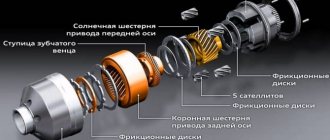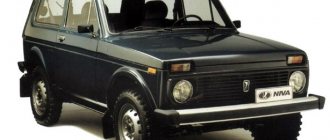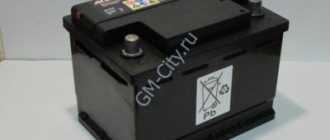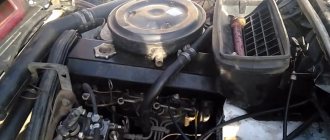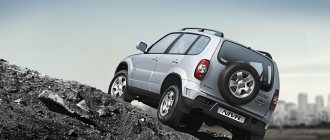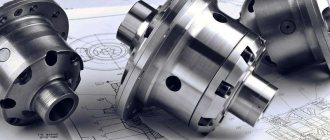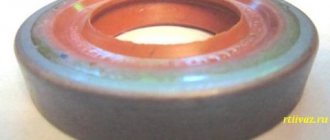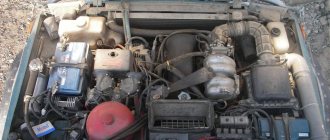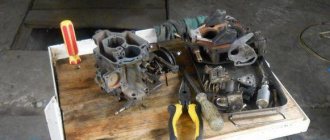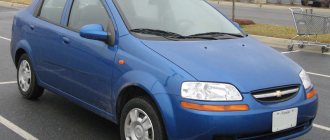- January 11, 2019
- Cars
- Eugene
The self-locking differential on the Niva, like any other analogue, is a device that serves to transform torque from the vehicle engine to the wheels using transmission elements. The factory free-configuration self-block cannot affect the other when one wheel slips. Blocking the part in question helps to obtain the necessary difference off-road. It increases the torsional moment on one of the wheels, which better grips the road. An alternative would be a forced blocking method. Let's try to figure out how effective the self-locking differential on the Niva is, as well as the method of installing this unit.
Peculiarities
Just because a vehicle comes with all-wheel drive does not mean it has all-terrain capabilities. Often, due to their design features, SUVs fall into the treacherous traps of sandy and washed-out roads. Domestic cars are far from an exception. There is an assumption that the self-locking differential on the Niva will be an important addition, especially if the owner plans to actively use the car in off-road conditions.
The limited slip differential, or self-block, as the part in question is also called, provides wheel stop automatically at the required time interval. It can be described as an intermediate option between the free analogue and complete blocking. The capabilities of both devices are optimally combined in the self-block.
Rules for using differential
These include:
- Switching the transfer case should only be done when the car is not moving.
- You can also engage the differential while the vehicle is moving.
- You can switch to a lower gear while the car is moving.
- To ensure long-term and uninterrupted operation of the differential, it is necessary to periodically turn it on, especially in winter. This should be done once every 7 days.
Shift lever location
In the interior of the Niva Chevrolet, there are two levers between the front seats . Using one of them you can change gears in the gearbox, and using the other you can control the transfer case.
Differential shift lever
The transfer case is based on a gearbox consisting of two stages . The control lever comes out of it into the cabin. He can move forward or backward. At the same time, it switches on/off downshift. If the lever is moved left or right, it can turn the differential lock on/off.
Gear shift and transfer case diagram
Downshift: what does it give?
The main component of the transfer case is the reduction gearbox . If the control lever is in the rear position, then the number of transfer cases decreases and is 1.2 . When the lever is in the forward position, the gear ratio increases. It will already be 2.1 . When the lever is in the neutral position, the gear ratio is 0 .
The differential is an integral part of the all-wheel drive mechanism in any car. It is recommended to use it only when the car is moving off-road.
Varieties
There are two main groups of self-locking differentials. The first type works depending on the angular speed parameters along the axes of the vehicle. In turn, these modifications are divided into several subtypes, namely:
- disk versions;
- models equipped with a viscous coupling;
- options with electronic action.
The second type includes mechanisms that are locked in accordance with the torsional moments on the axes. This group includes worm modifications.
In addition, there are inter-axle and inter-wheel self-blocks. With their help, torque is distributed between axles or wheels, respectively. The design of the mechanism, which can be symmetrical or asymmetrical, directly depends on the moment of force dispersion. On all-wheel drive SUVs, three sets of differentials are installed simultaneously, two between the wheels, one between the axles.
Functions of the differential device of the Niva Chevrolet
By automobile differential, experts mean a mechanical installation that includes a set of planetary gears and shafts. The functions of the Chevrolet Niva differential include the distribution of torque from the internal combustion engine of the vehicle to the drive wheels mounted on the same axle. Thanks to this, the car's wheels spin at different speeds.
The ability of the Chevrolet Niva wheels to spin at different speeds is very important when making turning movements. Especially when one wheel runs along a small radius, and the second wheel, located on the same axis, runs along a large radius. If there were no such device as an inter-wheel differential device, the vehicle's wheels would slip.
As a result of such spinning, the car would skid to the side, and the tires would wear out faster and lose their functional features.
When a Chevrolet Niva moves along a straight road at a constant speed, the inter-wheel differential device distributes the thrust from the internal combustion engine evenly between all wheels. This means that both driving wheels will rotate at the same speed. If any drive wheel slips, the differential will increase the traction force on the slipping wheel.
As a standard, a passenger car is equipped with one cross-axle differential on the drive axle. There are three such devices for the Chevrolet Niva; they are installed on:
- front axle;
- rear axle;
- at the center of the interaxial action.
A central differential device is needed to distribute the torque to both axles of the vehicle from the internal combustion engine.
[custom_ads_shortcode3]
Which is better to install a self-locking differential on the Niva?
A domestic SUV can be equipped with an electronic, combined, mechanical or pneumatic self-block. The first type model has a significant advantage over other versions. To activate it, you just need to press a button. The mechanism operates automatically, but only if the car is moving at a speed that is less than the threshold. The system shuts down when it reaches a mode higher than the nominal parameter.
The pneumatic version is a device mounted on both axles. The advantages of the mechanism include its compact size; the operating principle is based on the use of a pneumatic system. Self-block mechanical type is the cheapest and simplest in design. Reliability and operational efficiency depend on two semi-axial and a pair of spacer couplings, as well as pins and springs.
Parameters and selection criteria
The definition of a self-locking differential on a Niva is influenced by the car model, operating conditions, driving style, and other objective and subjective factors. For example, the ball version increases the load on the steering column, which radically changes the way the driver drives. This is fully expressed during turns and turns; if handled improperly, it leads to deformation of transmission parts.
The correct approach to choosing self-blocks is to take into account which axle of the vehicle will be equipped with the specified mechanism. This is due to the fact that the number of splines differs for different modifications. There can be 22 or 24 of them. Pay attention to the markings on the packaging. Usually there is information there, is it possible to install devices for a certain brand of car? Another point is the degree of transformation of the torsional moment (0.5 or 0.7). Here the choice depends on the owner of the car.
How to turn on all-wheel drive
Since the drive on the Niva is constantly all-wheel drive, the question of how to turn on the all-wheel drive on the Niva Chevrolet means how to turn on the center differential lock.
You need to use blocking in the following cases:
- when driving in difficult terrain where there is a danger of wheel slipping;
- when there is a lack of engine thrust;
- when driving on a road covered with snow or ice.
Important: Blocking is useless when the car is hung diagonally, when one wheel on different axles begins to slip. This is due to the design feature of the transmission. In this case, you need to act according to the situation - dig up or pour under the hanging wheels.
The main component of the axle locking mechanism is the transfer case. The transfer case is controlled by one six-position lever. The longitudinal stroke provides higher and lower gear rows. Transverse - responsible for locking the center differential. When the lever is in lock mode, a yellow icon lights up on the instrument panel. There are no synchronizers in the design of the transfer case, therefore, when you try to engage the speed range or lock, the gears clash tooth to tooth. To switch, you just need to move the car forward or backward and then everything will switch.
Advantages and disadvantages
To find out which is the best self-locking differential for the Niva, you need to compare the advantages and disadvantages in relation to the standard analogue of the car. The benefits include:
- Increasing the vehicle's maneuverability on steep, sliding and bumpy surfaces.
- There is no need to make changes to the design of the machine, since the self-block is mounted in place of the standard element. It is recommended to carry out installation work in a specialized workshop or do it yourself.
- The mechanism in question operates automatically and does not require special training for the driver.
Disadvantages of installing a self-locking differential on a Niva:
- steering becomes tighter, which requires additional effort;
- the working life is less than that of the factory element;
- driving style changes when cornering;
- there is no complete guarantee of blocking.
Various modifications of self-blocks have their own nuances, depending on the manufacturer, type of development, and installed components.
Why does Niva need blocking?
Wheel differential is a mechanism that allows a car to rotate its wheels at different speeds, which does not mean changing gears, but changing when cornering, when one wheel describes a small diameter and the other a large circle. In the absence of a differential, the wheels in the Niva would begin to slip, which could result in damage and rapid wear of the rubber.
When the vehicle moves on a flat road surface, the thrust from the engine is distributed evenly to the 4 wheels.
When at least one wheel slips, which often occurs on an icy road, the differential puts more force on the slipping wheel. In other passenger cars, such a device involves installation on a drive-type axle. Niva has it in other areas:
- on the rear and front axles;
- in the center between the axles, located near the gearbox and axles.
[custom_ads_shortcode2]
Removing axle shafts and bearings
To install a self-locking differential on a Niva 4x4, you need to carefully and efficiently remove the axle shafts. A special puller will be required. Otherwise, this is problematic, since the metal sticks to the slots. Stages of dismantling axle shafts and bearings:
- Unscrew all the bolt nuts on the plate element for fixing the axle bearing.
- The brake block is secured with bolts or fittings of a suitable diameter. If you ignore this procedure, the brake lines will come off.
- The axle shaft is removed directly using a special device.
- To dismantle the bearings, you will need a hydraulic press, which will make it easier to fit the race onto the shaft with high precision.
- Unscrew the wheel bearing nut and remove the bushing.
- Unscrew the fastening nut securing the lever with the rotary cam.
- Remove the stupor plate and remove the lever.
- Disconnect all fasteners, disconnect the hub with the brake disc and the knuckle. Dismantle the bearing, having previously fixed the rotating element in a vice. The bearing is also installed by pressing.
Advantages of forced blocking from IZH-TECHNO
What are the advantages of our forced blocking over existing analogues?
Forced locking kit
- The first, important point is the ease of installation and the availability of all the necessary components for installation . The differential assembly with our lock is installed in its standard place in the axle gearbox. You do not need to somehow “finish” the gearbox or purchase additional spare parts such as claw couplings or original axle shafts. Our locking is compatible with original axle shafts. All you need to install it is a standard set of plumbing tools. No “exercises” with a welding machine and grinder.
- Our locking system consists entirely of original components produced by IZH-TECHNO. Therefore, we guarantee the high quality of its individual components and locking elements; In turn, the high quality of components is a guarantee that you will not need any spare parts throughout the entire service life of the product, because there is simply nothing to break in it.
- We paid special attention to such a parameter as the strength of the satellite group . This is no coincidence: after all, it is she who transmits torque to both wheels of the axle and experiences the highest loads. The strength of the satellite group is confirmed by a series of tests carried out both in laboratory conditions and in real off-road conditions.
The lock has four satellites instead of the standard two
- The blocking has four satellites , instead of the standard two. This design allows for even distribution of torque and is more reliable than stock. We paid special attention to the parameters of the satellites themselves, increasing the thickness and height of the splines (see photo below):
On the left is a stock satellite, on the right is a satellite produced by IZH-TECHNO
- Protection of the pneumatic drive of forced blocking. The pneumatic drive is hidden inside the axle housing and is protected from mechanical influences; it cannot be broken or damaged.
- The differential housing is manufactured with high precision and strict tolerances , which ensures the absence of vibrations and noise in the axles when driving on the highway.
Niva differential housing cover
- Speed of blocking . By increasing the number of teeth involved in the differential locking, we achieved quick response of the locking mechanism. You don't have to wait for the wheel to rotate to 120 degrees for the system to finally work. In our case, 9 degrees will be enough.
- Versatility . The lock is suitable for all modifications and variants of Niva and Chevrolet Niva cars; it can be installed in both the rear and front axles, in both steel and aluminum front axle gearboxes. Locking options for 22 and 24 splines are available.
Read more about the features of forced blocking on Niva and Chevrolet Niva in the description on our website.
Assembly of the unit
When you have decided on the best self-locking differential for the Niva, you can begin assembling the unit. Initially, they adjust the gaps, which is not so simple. For this purpose, special washers of different thicknesses are used. Alternatively, accuracy is determined using a steelyard. One edge of the cord (about a meter in length) is wound around the flange, and the second is fixed to the scales. Pull the device in the winding, not forgetting to mark the turning point.
To ensure correct functioning of the gearbox, the elements are sealed before assembling the parts. If this is not done, soon after installation defects may appear, even to the point of complete breakdown of some parts. After treating the surfaces with sealant, wait until it dries completely. Next, the gearbox is filled with new oil. All sealing components with deformations and a hint of leakage are replaced. The mechanisms are assembled in a mirror order. After the replacement and installation of parts is completed, you should check the operation of the brake unit. This is very important, since malfunction of parts affects road safety.
Self-locking system
Can be configured to the required switching threshold. This can be either a slight slip or uneven distribution of torque among the wheels. Such a connection is not rigid, and therefore does not place unnecessary load on the interaxial connection.
When installing a forced locking system on a Chevrolet Niva, you should remember that a constantly turned on system can put unnecessary stress on the transmission, so you should turn it on only when overcoming difficult sections of the road.
What are users saying?
As reviews indicate, it is not advisable to install a self-locking differential on a Niva in all cases. If the driver intends to constantly operate the vehicle on serious and difficult off-road conditions, installing a self-block makes sense. When driving regularly around the city or on a country road, this idea is irrelevant. The existing factory analogue copes well in such cases on its own, and it has a longer service life.
In addition, users recommend installing the mechanism themselves only if the owner has the appropriate skills and a clear understanding of the design features of the vehicle. Otherwise, use the services of a car service. The choice of the configuration of the self-block and the location of its installation depends solely on the preferences of the owner of the machine.
Enabling the differential lock
On the Chevrolet Niva it is possible to turn on all three differentials at the same time . Thanks to this, the vehicle’s cross-country ability increases several times when driving off-road.
Forced locking means that the drive wheels are combined with each other, as a result of which they can rotate at the same speed. Thanks to the blocking, the traction force of the engine will be used to the maximum and transmitted to the wheels.
As already mentioned, the differential assembly consists of shafts and gears. With their help, the traction force is automatically distributed between the drive wheels. The differential is locked using a blocker (clutch) . In this case, when the driver turns on the forced locking, the wheels “become” connected to each other. This helps ensure that they rotate evenly.
Differential assembly
If the center lock is forcibly engaged, then the front and rear axles are also rigidly connected at once, which guarantees an even distribution of traction to all four wheels. Thus, the vehicle’s cross-country ability will be increased several times , which makes the Chevrolet Niva a real SUV.
Applying a lock
Not all cars are equipped with blockers, and therefore they will be vulnerable off-road. In this regard, Chevrolet is a unique car that can move with either one or all-wheel drive , which allows it to feel confident even on mountain roads.
To engage the differential lock, pull the lever all the way to the left.
Forced blocking should be enabled in the following cases:
- When overcoming difficult sections of the route. In this case, the blocking should be turned on in advance, even before leaving for such an area.
- On steep climbs or slopes when wheel slip is possible.
- When driving on sand.
- When driving on snow or ice.
Disable blocking
When the Niva moves on a regular road with a smooth surface, it will not need to lock all wheels. They will adhere normally to the surface and not slip, since the traction force from the engine will be distributed evenly over them. For this reason, when the car is moving on a good road where the wheels will not slip, the use of a differential will not be required .
